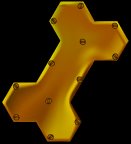 Welcome to one series I've been thinking of for a while. The inspiration was Skepticality's "Whimiscality" on the number five. I'll be rambling on my favorite two-dimensional shape: The hexagon. For those of you who've fallen behind on your geometry, the hexagon is a six-sided polygon.
Welcome to one series I've been thinking of for a while. The inspiration was Skepticality's "Whimiscality" on the number five. I'll be rambling on my favorite two-dimensional shape: The hexagon. For those of you who've fallen behind on your geometry, the hexagon is a six-sided polygon. A regular hexagon (all sides and angles equal) has all angles at 120 degrees. Because of this, three hexagons can join together at a common vertex seamlessly, since 120 x 3 = 360. Thanks to this little property, you can form a mosaic of hexagons known as a tessellation. The only other regular polygons that can do this are the triangle and the square.
A regular hexagon (all sides and angles equal) has all angles at 120 degrees. Because of this, three hexagons can join together at a common vertex seamlessly, since 120 x 3 = 360. Thanks to this little property, you can form a mosaic of hexagons known as a tessellation. The only other regular polygons that can do this are the triangle and the square.Unlike the square and the triangle, there are no platonic solids made of hexagons. Hexagons, however, do commonly find themselves in archimedean solids, including one of the most simple:
 The truncated tetrahedron, which is essentially a tetrahedron with the points cut off. The hexagon is also a part of the archimedean solid known as the truncated icosahedron, also known as the buckyball, named after Richard Buckminster Fuller, who had a great enthusiasm for the shape. Buckminsterfullerene, a buckyball-shaped carbon molecule, along with other molecules of its sort, seems to have a lot of research potential. Fullerenes have a number of unusual properties, including being the only known allotropes of carbon that can be dissolved.
The truncated tetrahedron, which is essentially a tetrahedron with the points cut off. The hexagon is also a part of the archimedean solid known as the truncated icosahedron, also known as the buckyball, named after Richard Buckminster Fuller, who had a great enthusiasm for the shape. Buckminsterfullerene, a buckyball-shaped carbon molecule, along with other molecules of its sort, seems to have a lot of research potential. Fullerenes have a number of unusual properties, including being the only known allotropes of carbon that can be dissolved.Returning to hexagonal tessellations, graphite, another carbon allotrope, takes on the form of sheets of hexagons, weakly bonded with each other. Another carbon form is the benzene ring, a hexagon of carbon atoms with other atoms, usually hydrogen, bonded to the available verticies.
No entry on the hexagon would be complete without mentioning honeycombs, the basic units of a beehive. Bees likely evolved to form hexagonal honeycombs because they were the most effiencient use of space while retaining strength.
Oddly, France is sometimes nicknamed "l'hexagone" because, with a little imagination, the nation can be seen as a hexagon.
On a more personal note, hexagonal grids are often favored in some role-playing and strategy games: Distances on a hex grid are constant between two points: There's no need to deal with diagonals.
4 comments:
Distances on a hex grid are constant between two points: There's no need to deal with diagonals.
Cool!
I remember how thrilled I was when I first saw a program on Fullerenes back in the late 80s or early 90s. It's one of the things that helped me start to understand just how incredible science in general really is. The bond between those things may yet snake into orbit as part of the Space Elevator. If they ever finance it well enough.
One bit of idle curiousity vaguely relevant: In Fullmetal Alchemist, they have the homonculous Greed, AKA the ultimate shield. He manipulates the carbon in his body to create armor. It wasn't specified what he turned it into, though black diamond is one reasonable guess. Just how good would fullerenes be as armor?
Something else I've been thinking about: I think truncated tetrahedrons would be good for d4s: Could have the numbers on the triangles, so that you wouldn't have to deal with the "look at the bottom" sort. It's also a rounder shape, so they'd roll better.
Wish I could find a place that'd make 'em like that.
Weren't all the micro-biospheres of Jack Chalker's Well World books shaped like hexagons?
Post a Comment